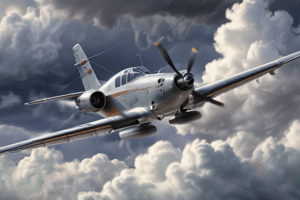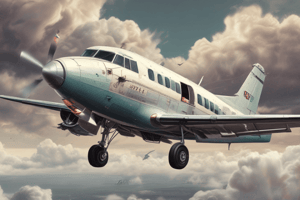Podcast
Questions and Answers
What is the primary reason for an aircraft requiring a longer takeoff roll on warmer days?
What is the primary reason for an aircraft requiring a longer takeoff roll on warmer days?
- The decrease in air density means the aircraft produces less lift (correct)
- The air molecules are more tightly packed, increasing air resistance
- The warmer air causes the engine to overheat
- The engine's thrust is more effective in less dense air
How does humidity affect the air density?
How does humidity affect the air density?
- Humid air is more dense than dry air
- Humidity only affects air density at high altitudes
- Humid air is less dense than dry air (correct)
- Humidity has no effect on air density
What is the effect of humidity on engine power output?
What is the effect of humidity on engine power output?
- Humidity only affects engine power output at high altitudes
- Humidity increases engine power output
- Humidity has no effect on engine power output
- Humidity reduces engine power output (correct)
Why is it essential for pilots to understand how atmospheric conditions affect aircraft performance?
Why is it essential for pilots to understand how atmospheric conditions affect aircraft performance?
What happens to the rate of climb in less dense air?
What happens to the rate of climb in less dense air?
What is the purpose of understanding how atmospheric conditions affect aircraft performance?
What is the purpose of understanding how atmospheric conditions affect aircraft performance?
How does air density change as temperature increases?
How does air density change as temperature increases?
What is the effect of high humidity on an aircraft's wings?
What is the effect of high humidity on an aircraft's wings?
Why do pilots need to be aware of changes in temperature and humidity?
Why do pilots need to be aware of changes in temperature and humidity?
What is the result of an aircraft operating in high humidity conditions?
What is the result of an aircraft operating in high humidity conditions?
On cooler days, an aircraft will require a shorter takeoff roll due to increased air density.
On cooler days, an aircraft will require a shorter takeoff roll due to increased air density.
Humid air is denser than dry air due to the added weight of water vapor.
Humid air is denser than dry air due to the added weight of water vapor.
Aircraft performance is only affected by temperature, not humidity.
Aircraft performance is only affected by temperature, not humidity.
In high humidity conditions, an aircraft will experience an increase in lift due to the added moisture.
In high humidity conditions, an aircraft will experience an increase in lift due to the added moisture.
Pilots can ignore weather reports and forecasts because they are not essential for safe flight operations.
Pilots can ignore weather reports and forecasts because they are not essential for safe flight operations.
Air density remains constant regardless of temperature changes.
Air density remains constant regardless of temperature changes.
Engine power output is not affected by humidity.
Engine power output is not affected by humidity.
Aircraft performance is only affected by changes in air pressure, not temperature or humidity.
Aircraft performance is only affected by changes in air pressure, not temperature or humidity.
In low humidity conditions, an aircraft will experience a decrease in lift due to the lack of moisture.
In low humidity conditions, an aircraft will experience a decrease in lift due to the lack of moisture.
Pilots do not need to consider atmospheric conditions when planning a flight.
Pilots do not need to consider atmospheric conditions when planning a flight.
What happens to the air molecules as temperature increases, and how does it impact aircraft performance?
What happens to the air molecules as temperature increases, and how does it impact aircraft performance?
How does humidity impact air density, and what are the consequences for aircraft performance?
How does humidity impact air density, and what are the consequences for aircraft performance?
What must pilots be able to do with weather reports and forecasts to ensure safe and efficient flight operations?
What must pilots be able to do with weather reports and forecasts to ensure safe and efficient flight operations?
How do changes in air density impact an aircraft's climb rate?
How do changes in air density impact an aircraft's climb rate?
What is the main reason pilots need to understand how atmospheric conditions affect aircraft performance?
What is the main reason pilots need to understand how atmospheric conditions affect aircraft performance?
How do temperature and humidity changes impact an aircraft's overall performance?
How do temperature and humidity changes impact an aircraft's overall performance?
What happens to an aircraft's engine power output in high humidity conditions?
What happens to an aircraft's engine power output in high humidity conditions?
Why is it essential for pilots to consider atmospheric conditions when planning a flight?
Why is it essential for pilots to consider atmospheric conditions when planning a flight?
How does air density change as humidity increases?
How does air density change as humidity increases?
What is the ultimate goal of understanding how atmospheric conditions affect aircraft performance?
What is the ultimate goal of understanding how atmospheric conditions affect aircraft performance?
Flashcards are hidden until you start studying
Study Notes
Temperature's Impact on Aircraft Performance
- High temperature causes air to expand and become less dense, similar to climbing to a higher altitude
- Lower air density means:
- Wings generate less lift
- Engines produce less thrust due to less air to work with
- This concept is related to pressure altitude, where air pressure matches the standard atmosphere at sea level
- As temperature rises, pressure altitude increases, affecting aircraft performance as if flying higher than actual altitude
Humidity's Impact on Aircraft Performance
- Humidity refers to the amount of water vapor present in the air
- More water vapor means air is lighter, displacing some of the air and reducing air density
- Effects of humidity:
- Reduced engine performance and efficiency due to less oxygen-rich air
- Decreased lift generated by wings
Combined Impact of Temperature and Humidity
- High temperatures and humidity can:
- Decrease lift
- Increase required runway length
- Diminish climb rate
- This combination directly affects takeoff and climb performance, critical for safe flight operations
- High temperature and humidity also affect aircraft range and endurance, requiring additional fuel consumption to achieve the same thrust
Importance of Considering Atmospheric Conditions
- Pilots must understand and adjust for temperature and humidity changes to ensure safe and effective flight operations
- Continuous monitoring, evaluation, and adjustment are crucial components of pilot skill
- Considerations include:
- Checking METAR reports pre-flight
- Adjusting throttle settings mid-course
Temperature's Impact on Aircraft Performance
- High temperature causes air to expand and become less dense, similar to climbing to a higher altitude
- Lower air density means:
- Wings generate less lift
- Engines produce less thrust due to less air to work with
- This concept is related to pressure altitude, where air pressure matches the standard atmosphere at sea level
- As temperature rises, pressure altitude increases, affecting aircraft performance as if flying higher than actual altitude
Humidity's Impact on Aircraft Performance
- Humidity refers to the amount of water vapor present in the air
- More water vapor means air is lighter, displacing some of the air and reducing air density
- Effects of humidity:
- Reduced engine performance and efficiency due to less oxygen-rich air
- Decreased lift generated by wings
Combined Impact of Temperature and Humidity
- High temperatures and humidity can:
- Decrease lift
- Increase required runway length
- Diminish climb rate
- This combination directly affects takeoff and climb performance, critical for safe flight operations
- High temperature and humidity also affect aircraft range and endurance, requiring additional fuel consumption to achieve the same thrust
Importance of Considering Atmospheric Conditions
- Pilots must understand and adjust for temperature and humidity changes to ensure safe and effective flight operations
- Continuous monitoring, evaluation, and adjustment are crucial components of pilot skill
- Considerations include:
- Checking METAR reports pre-flight
- Adjusting throttle settings mid-course
Temperature's Impact on Aircraft Performance
- High temperature causes air to expand and become less dense, similar to climbing to a higher altitude
- Lower air density means:
- Wings generate less lift
- Engines produce less thrust due to less air to work with
- This concept is related to pressure altitude, where air pressure matches the standard atmosphere at sea level
- As temperature rises, pressure altitude increases, affecting aircraft performance as if flying higher than actual altitude
Humidity's Impact on Aircraft Performance
- Humidity refers to the amount of water vapor present in the air
- More water vapor means air is lighter, displacing some of the air and reducing air density
- Effects of humidity:
- Reduced engine performance and efficiency due to less oxygen-rich air
- Decreased lift generated by wings
Combined Impact of Temperature and Humidity
- High temperatures and humidity can:
- Decrease lift
- Increase required runway length
- Diminish climb rate
- This combination directly affects takeoff and climb performance, critical for safe flight operations
- High temperature and humidity also affect aircraft range and endurance, requiring additional fuel consumption to achieve the same thrust
Importance of Considering Atmospheric Conditions
- Pilots must understand and adjust for temperature and humidity changes to ensure safe and effective flight operations
- Continuous monitoring, evaluation, and adjustment are crucial components of pilot skill
- Considerations include:
- Checking METAR reports pre-flight
- Adjusting throttle settings mid-course
Studying That Suits You
Use AI to generate personalized quizzes and flashcards to suit your learning preferences.



